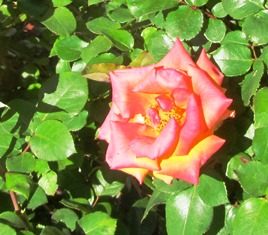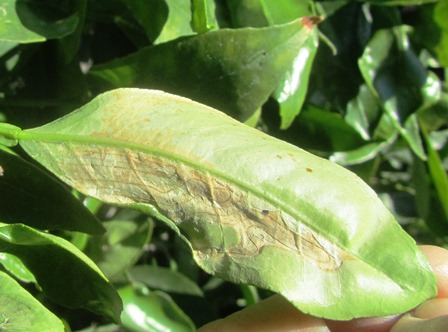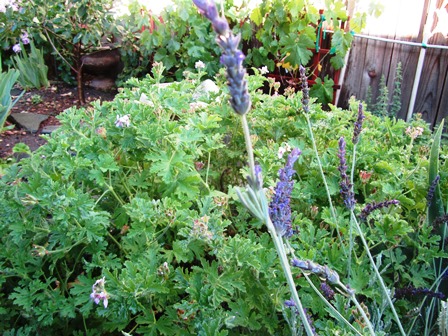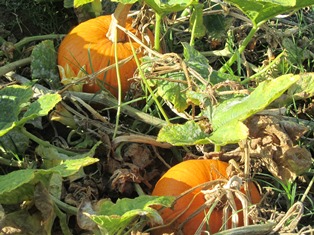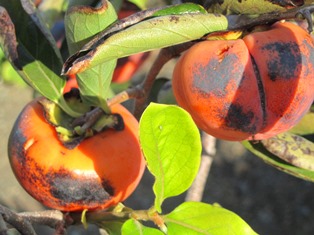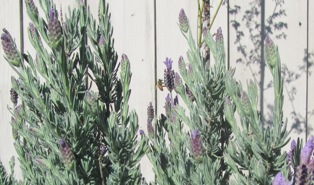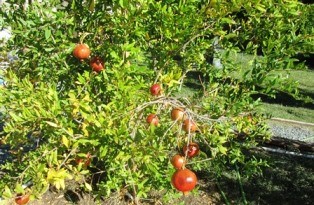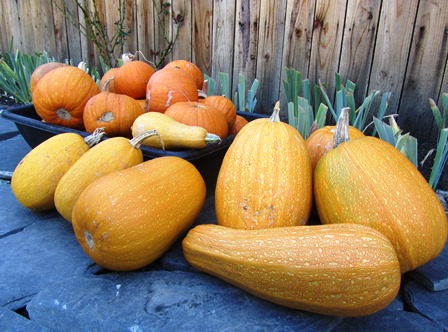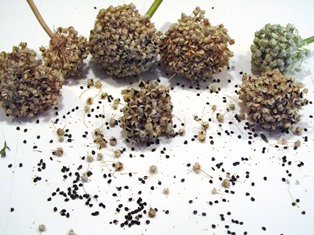Archive for the 'Plants and Trees' Category
Working the Beds after the Weekend Storm
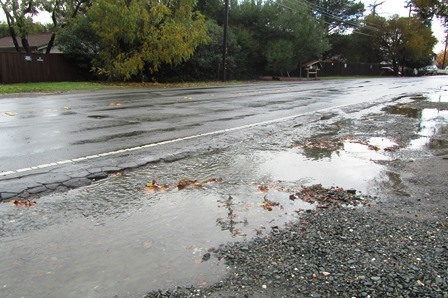
A “Pineapple Express” rainstorm with gale-force winds blew out the power and made for slick roads as well as ponds in our clay soil
The weekend storm is still a vivid memory, what with the fence along one side of my property beaten down by high winds and pounding rain that also brought a power outage on Friday night.
But today with outside temperatures in the 70s Fahrenheit, I cleaned my strawberry beds. Somehow, mint had crept in and I don’t want mint with my berries although I like it served that way for dessert.
My neighbor’s relative, who’s visiting from Lebanon where they grow apples in his mountain village, share a suggestion for digging dried chicken manure around the bases of my trees. The high nitrogen will get them off to a great start and my trees have already broken bud (which is attracting the honeybees).
The wild bird population seems to have exploded and I see signs of nest building starting. The five suet cakes I hung in trees for the songbirds, blue jays, and woodpeckers last month are down to a fraction of their original size.
I extended the chicken run with poultry wire high enough to keep the my heritage girls from flying out. Now, they’ll have plenty of space on both sides of the chicken house to forage and out the beds I’m working.
Speaking of Roses
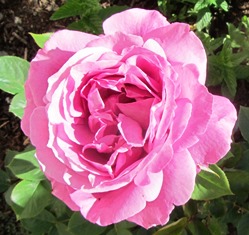
This candy-stripe rose was a gift from a friend–a cutting from her rose that became a large bush in my garden
If you love roses like I do, you probably already have a few growing in your garden. Perhaps you also look forward during long winter evenings to perusing the offerings in the catalogs of rose growers and dreaming of new varieties to plant in the spring.
Whether you are new to growing roses or have been gardening with them for a while, a review of types and species might be in order, especially before you plan a visit to your local gardening center. Bare root roses will start arriving in about three weeks here in Northern California.
TYPES OF ROSES
Roses fall roughly into four general categories: Bush Roses (this is the largest group and includes hybrid tea, polyantha, floribunda, heritage or old rose, miniature, and tree roses), Climbing Roses (large-flowering climbers have canes to 10 feet, ramblers have canes to 20+ feet and small flowers in early summer), Shrub Roses (upright growth habit reaches 4 to 12 feet and may only bloom once during summer), Groundcover Roses (also called carpet roses, these grown in low mounds and can bloom only once or repeatedly).
SPECIES of ROSES
Alba–These beauties are white or palest pink with gray-green foliage.
Bourbon–Repeat bloomers that have a wide height range and glossy green foliage.
Centifolia–These stunning beauties were favored by the Dutch master painters. Centifolia roses contain many petals on cold-hardy plants that grow 4 to 8 feet tall.
Climbers–These roses come in a wide variety of bloom type and color and have long, arching canes.
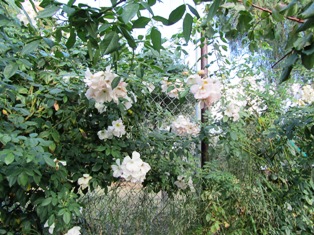
Climbing Sally Holmes produces large sprays of white to palest pink roses along the back fence of our property, from early spring to frost
Damask–May bloom only once although some varieties will repeat; the flowers are white or soft pink and fragrant. For centuries, this was the rose species used to produce Attar of Roses.
Florabunda–Produces sprays of roses and is a repeat bloomer.
Grandiflora–Similar to hybrid tea roses, the grandiflora blooms on long canes and is associated with the high-centered blooms so often seen in floral shops.
Hybrid Gallica–An old rose that blooms in the spring; flowers are pink or red or even striped and emerge on plants that stand about 4 feet tall.
Hybrid Perpetual–These roses were especially loved in the 1800’s for their red and pink color, repeat flowering, and height of six feet.
Hybrid Tea–Blooms on long canes as a single bloom or sprays of flowers.
Polyantha–Smaller blooms than the florabundas but can produce large sprays in repeated flowering.
Noisette–Plants tend to be large and often sprawl but can produce fragrant clusters of blooms and are repeat-flowering. They are sensitive to cold and frost.
Miniature–Small roses ranging in height from 1 to 3 feet with miniature flowers and foliage.
Shrub–Hybrid rugosas are an example of the shrub varieties (of which there are many). Often these roses have lots of prickles.
Tea Roses–These plants have quite large blooms, but the drawbacks include weak canes and a susceptibility to frost and cold. Their height and bloom color can vary widely.
Spate of Warm Weather Brings Out Early Blosssoms
While schools across the nation are taking snow days because of frigid temperatures, the fruit trees on my Bay Area farmette are showing signs of bud swelling and early blossoming because of a winter heat wave.
Cities around the San Francisco Bay are experiencing early January temperatures of 70-plus degrees Fahrenheit, breaking weather records in some areas. Mother Nature certainly behaves strangely at times.
My five-variety apple tree and the early Desert Gold peach trees are covered with buds that are already showing color. I haven’t as yet gotten around to the winter pruning and spraying with organic oil. Maybe if there’s no wind today, I’ll squeeze that chore in with the others.
I did cut back the Washington navel orange that is infected with Leaf Miner, a pest that’s crossed the United States from Florida. It attacks new leaves, so I’m thinking if I prune and spray now before spring is in full swing, maybe I won’t lose this tree. Curiously, the pest hasn’t widely infected my blood orange trees but there are signs of it in the leaves of our Satsuma seedless tangerines.
Elsewhere, I’ve done deep digging in the chicken run and added some wood chips and leaf material for compost.
The tea roses have been pruned back to 12 to 18 inches and old canes removed. I’m torn between wanting to add more roses in the beds in front of the bamboo plants on the east/west axis of our property or adding more lavender and sunflowers, favored by the bees.
Tomorrow, I’ll open and inspect my bee hives. I left honey stores this past autumn instead of harvesting. But if the bees have gone through all the honey, then I’ll have to add bee food until we get the first early bulb blooms and wildflowers. The French perfume lavender that the bees love is about the only bloom (bee food) in the garden now. Luckily, I planted a lot of it.
The farm chores don’t just seem endless, they are. But whether the work is daily, weekly, or seasonal, there’s something deeply rewarding–even magical–about living close to the earth in harmony with cycles of seasons and the rhythms of nature. But I admit, it is a little strange to have such warm weather when winter has only just started.
Finding Surprises in my December Garden

Open-pollinated, heirloom tomatoes produced lots of tasty fruit over the summer, but . . . in December?
It’s the second week of December and the Winter Solstice is about to arrive next week. Walking through the bleak garden landscape, I wasn’t expecting any of my summer plants to still be producing. But surprise, surprise.
A cluster of red grape tomatoes were still clinging to a vine that had become overgrown by weeds. Not only was fruit still hanging on the vine, but the plant was setting up new blooms. I can only assume the reason for that is that we’re having unseasonably warm temperatures in the Bay Area.
I harvested a 10-pound bag of red and yellow onions at summer’s end. Now I’ve got a new bed where the onion heads re-seeded. I do hope these bulb onions make it through to spring. I might just build a cold frame over them.
In raised beds, the jalapeno and Thai chili peppers that wilted and drooped during the terrible drought this summer have responded to recent rains with lots of ripe peppers and also new blooms.
It’s very strange as these babies need water and high heat; our Bay Area temperatures are hanging in the 60s Fahrenheit during these early days of December.
I harvested the pumpkins and squash but hadn’t yet pulled out the old vines for composting. The hard-skinned pumpkins and squashes can be peeled, cut into cubes, and frozen for use later in culinary creations such as soup.
Further on, I picked the last of the persimmons and pomegranates. These are my favorite fall fruits. And if you’ve ever dropped ripe pomegranate seeds onto the ground, you’ll soon see that the chickens love them, too.
Having uncovered all the garden’s surprises, my thoughts turn to how I’m going to lay out the garden next year and which heirlooms to grow. The garden soil needs to rest as we Bay Area gardeners welcome the rain now that the Pacific storm door has finally opened.
Leafminer Larvae Can Destroy Young Citrus Trees
The new leaves on nearly all our citrus trees show signs of the presence of the citrus leafminer. The local garden center representative explained this pest is ravaging trees in our area. The pest’s name is fitting–its larvae tunnel into new leaves creating mining tunnels.
This pest came to California in 2000 by way of Florida, where it showed up in 1993 and began steadily moving westward. The citrus leafminer is native to Asia, but in the 1940s, it showed up in Australia. From there, it began to appear in other citrus-growing regions of the world.
The citrus leafminer is a small, light-colored moth. Its forewings are irridescent. The wing tips have a black spot. The hind wings and its body are white. Look for a serpentine tunnel on a new leaf and inside the tunnel is thin dark line, the frass (or feces) trail.

The citrus leafminer burrows into new leaves, creating tunnels that, in turn, make for an exotic mosaic appearance on the leaves
In its last stage before adulthood, the larva causes the leaf the curl up. The curling is the result of the larva rolling the leaf end around itself in order to pupate as it becomes an adult moth.
Older, hardened citrus leaves are not at risk. The citrus leafminer attacks only young, shiny, green, new leaves. Young trees are perhaps at greatest risk.
Citrus growers should prune their trees only once each year because pruning causes a flush of new growth, open for attack. Because of the difficulty of getting the product inside the tunnels, chemical control is not recommended. Also, traps using a pheromone attracts only the male moth. It gets stuck inside, but this won’t eliminate the citrus leafminer population.
Biological control is accomplished through parasites and predators. The non-stinging wasps, Cirrospilus and Pnigalio species are particularly effective against citrus leafminer since the parasites lay eggs inside the leafminer tunnels, either inside or on the top of the citrus leafminer larvae. The parasite egg hatches and the parasite larvae eat the leafminer larva. You don’t have to put these pests in your garden. They are attracted to citrus just like the leafminer is.
Nature has a powerful checks-and-balance ecosystem that works best when growers do not spray insecticides. Pesticides and insecticides disrupt predator activity and nature’s inherent balance.
The Bee Garden Favorites
I spent Sunday building a rock circle around the circumference of our towering elm tree. I want to conserve water around the base of the tree and to also grow more plants for my bees to have abundant food.
We had a pile of river rock donated to us, so I thought it might look nice to create a wide circle, maybe three feet high around the tree like a watering basin/retaining wall, using the rock.
Inside the circle, I transplanted some yarrow and white geranium. Already, there are white roses that boom all summer long under the tree.
But bees like nectar-rich plants with pollen, so I’ve put together a list. Over the next week, I’ll add some of these in my new bed beneath the elm. This is a partial list of plants bees love.
- Rosemary
- Lavender
- Russian sage
- Basil (African blue)
- Honeywort
- Mexican Sunflower
- Borage
- Cerinthe
- Greek oregano
- Sweet marjoram
- Purple coneflower (echinacea)
- California poppies
- Lupine
- yarrow
- sunflowers
Eucalyptus on the property behind our farmette is not yet covered with fall bloom. The bees love that bloom but now they make do with the star thistle on the brown hillsides and by foraging on the French perfume lavender and the Spanish variety in my garden.
Of late, I’ve discovered the honeybees foraging on the sweet nectar at my hummingbird feeders, so I worry about them getting enough food. The drought has sapped everything. At any rate, I’ll hold off taking honey this fall, leaving it in the hives for the bees. They’ll need food to get through the rainy season.
To-Do List of Chores for the Fall Garden
From my office widow, I look out over what once was a lush and thriving garden. Not so today.
I can hardly bear to gaze upon the sorrowful, dried tomato vines that for me have come to symbolize the severity of the extreme drought on California gardens.
Now that fall will soon arrive, I’ll toss onto the compost pile those vines along with others from pumpkins and hard-shelled squash.
So with the garden cleared, I’m thinking ahead to next year, ever hopeful we’ll get rain rather than a repeat of dry conditions like this past year.
To ensure the viability of our fruit trees, citrus trees, and various berries through the fall and winter, there is a spray regimen to be initiated. I’ll add it to my long list of chores that will need to be done.
MY FALL CHECKLIST FOR THE GARDEN
Turn the soil, add amendments like compost to hold in the water.
Prepare new beds.
Build cold frames and 4- x 6- foot boxes for new raised beds.
Cut the canes of blackberries (berries only set up on two-year-old canes that won’t again produce; cut to ensure new fruiting canes will take their place).
Prune away the spent floricanes of red raspberries, once they’ve produced fruit.
Clean up around the bases of all trees and evergreen plants; add mulch.
Also remove all leaves at the base of all fruit trees and dispose.
Remove rose leaves after blooming season, cut canes to 18 inches, and spray for diseases and pests.
Stake young trees so they’ll survive windy winters, growing straight and tall.
Treat the trees with an organic spray (one containing copper and protector oil) to prevent fungal disease and pests.
Get out the frost cloth in readiness to cover tender citrus trees.
Prune back the hydrangeas.
Plant fall bulbs for spring flowering.
Pumpkin and Squash–Dealing with Vine Sprawl
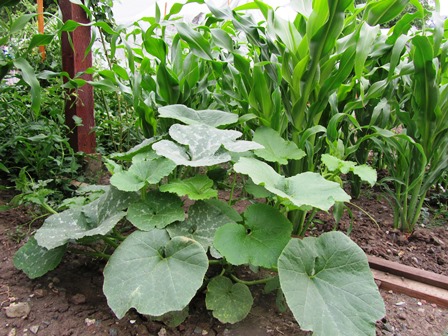
A squash plant will grow well in small gardens on supports such as a teepee of three poles tied together or on a fence
With the California drought looking like there’s no end in sight, I began pulling what I could from the garden. A lot of the space was taken up this year with squash and pumpkins. Vines are everywhere.
It’s my own fault for not keeping a better control over the direction of the vines. I could have grown them up and over a support, but I didn’t. Once ignored,the vines took over the whole garden, more than 25 to 30 feet in almost every direction.
I grew mainly heirloom varieties of squash and the French sugar pumpkins. One pumpkin plant reseeded from last year. Those vines climbed up into the five heirloom tomato plants, two apricot trees, and headed out toward the Lady Banks Rose and the Climbing Sally Holmes roses that border the garden. Inching even further, the squash vines moved out of the garden into the back yard.
No doubt about it, I’m going to have to pull on work gloves and a straw hat and get out there to dig out those dried vines and pull them out. Next year, trellises and supports for everything. Water is a commodity in crisis right now, at least in this state and everyone has to do their part. We’re just going to harvest the squash and pumpkins early and pray for early rains.
Scented Geraniums
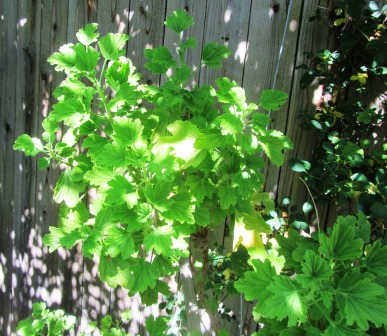
This lemon-scented Pelargonium crispum thrives in part shade and produces inch-wide, white-and-pink blooms
Brushing up against the leaves of a scented geranium releases fragrance to the area where they grow. It’s the main reason why these varieties are grown because those that bloom do not flower as colorfully or profusely as zonal geraniums.
They do, however, require the same care as zonals. They do best in well-drained, loose soil and this applies whether they are grown in pots or in the ground. They need water, but can tolerate some dry conditions.
Some scented geraniums grow from four-to-six feet tall with rounded leaves and range from a half inch to six inches (similar to oak leaves). Rubbing the leaves gently releases their potent and pleasing aroma.
Growing scented geraniums is easy and a delight to the senses. Why not try some in your garden? The following is a list of scented geraniums, suggestive of their diversity:
- Pelargonium crispum; lemon fragrance
- Pelargonium denticulatum; pine fragrance
- Pelargonium x fragrans; nutmeg fragrance
- Pelargonium graveolens; rose fragrance
- Pelargonium x nervosum; lime fragrance
- Pelargonium odoratissimum; apple fragrance
- Pelargonium scabrum; apricot fragrance
- Pelargonium tomentosum; peppermint fragrance
A Drought Is No Way to Dry Onions
With water use restricted in many counties because of the terrible drought, my garden is withering. Everyone in the Bay Area has to do their part. My onions look particularly pathetic.
In July, I polished a mystery I had hoped to sell. Mid-month, BEELINE TO MURDER sold to Kensington Publishing in New York as the first in a three-book deal. That meant I had to get cracking on the second book.
I forgot the onions. Poor things. The tops fell over and wilted, the bottoms swelled and stopped. A few succumbed to the soil organisms and bugs.
August rolled around and I looked over the patch of brown stems and the heads that had gone to seed and vowed to dig everything out. But then . . . I got an offer to write a short nonfiction book that tied into the Law of Attraction, one of my favorite subjects. The onions had to wait for another 20 days until I cranked out that project.
Yesterday, my husband harvested the onions. Some have to be tossed because of bottom rot. Anything ignored will wither and die–that’s an axiom of gardening I’ve known since forever. So, the onions are gone, but their seeds are plentiful (thousands), so this fall I will plant a new crop of onions and another in the spring and pray for rain.
 Facebook
Facebook Goodreads
Goodreads LinkedIn
LinkedIn Meera Lester
Meera Lester Twitter
Twitter






